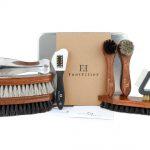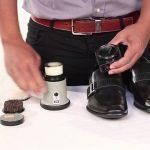You can stop shoes from squeaking by trying the following actions: Place your shoes in the dryer, sprinkle with baby powder, try to soften the sole, add petroleum jelly and rub your soles, Rub WD-40 on saddle soap and finally Repair sloppy heels

Related: Can You Super Glue the Sole of a Shoe? Does Saddle Soap Remove Polish? How Do You Clean Farm Boots?
How to Stop Shoes from Squeaking
The short answer is that the squeak from a shoe can be caused by any of the shoe’s parts, so, if you do not want to spend time to track it down, you can hit all 3 main areas. Use sandpaper to scuff up the soles, use talcum powder to dry up the inside of the shoe and use saddle wax to grease the tongue of the shoes.
If you want to be more specific and pinpoint the actual cause of the squeaking, or you are one of the few cases where that does not work then read on. We will break down all the potential causes for squeaks and see what solution we can use to tackle them.
How to find out where the squeak is coming from
There are plenty of reasons why shoes squeak. In my own experience it is usually new shoes with hard soles that squeak, and, because I associate the sound with basketball and athleticism, I tend to like it. The only caviat is that the squeak has to come from the sole.
Start by walking on a carpeted surface and trying to do a few basketballs, one foot style turns and twists. If there is no sound whatsoever coming from the shoes, then you know the outer sole is the problem.
If the sound persists even when walking on carpet, try to gently step backward and forwards while slowly rolling throughout the entire sole of the shoe.
If you remember those old Bugs Bunny cartoons where Bugs was trying to walk quietly for effect by placing only his toes on the ground first and then rolling down the rest of the foot then you know exactly what to do. If the sound is coming only when you finally land the heal, you probably have a crack somewhere in the heal.
Most of the times, though, you will hear the squeak only as you start rolling down from your tows to the balls of your feet. In that case, you need to undo your shoelaces completely and run the experiment again.
If the squeak has disappeared, you know the tongue of the shoe rubbing against the shoelaces was creating the problem. If the sound persists, it was the insole rubbing against the bottom sole.
Once you have identified the problem it should be fairly easy to implement the easiest solution as described in the first, bolded paragraph. Sandpaper for the soles can be had here, talcum powder here, and some affordable saddle soap can be had here.
If you do not like the options provided so far, there are a couple of alternatives for each situation discussed below.
How to stop shoes from squeaking on hard floors
If the shoes squeak when walking on a hardwood floor only, there is a good chance that the problem is with the soles of the shoes and nowhere else.
However, you may be wearing older, broken in shoes, in which case the sandpaper will not do much. Or you may not want to take an abrasive material to your brand new shoes. So, let’s take a closer look at each of the above options.
If your shoes are fairly old, there is a good chance the sandpaper will not help. However, because they are old they are likely coming apart at the seams.
Most people would actually through them away at this point, however, you can still get a season or two out of them if you can manage the area where they are coming apart.
Most people don’t have the skills to saw shoes together, and you should not even attempt it.
The simple solution is to use shoe glue and put them back together. A word of caution here would be to use actual shoe glue, not super glue or whatever else you might have around. Most glues dry to a rigid form, but shoe glue stays flexible even after it dries so it moves with the shoes and does not come off.
If your shoes are new and you really do not want to use sandpaper, there is a controversial alternative. You could spray some WD40 on the soles of the shoes, leave it to absorb for about 3 minutes, and then wipe it off with a paper towel.
This solution is so controversial because you are basically getting your shoes to be extra slippery. By whipping the excess off, you will get a lot of the grip back into your shoe, but still, you should proceed at your own risk and be extra careful when you walk around.
The other problem with this solution is that in 3 days at best, the WD40 will be completely gone and the squeaking will be back. The only good news is that the natural wear and tear will eventually get your shoes’ soles worn down enough to stop squeaking on their own.
Related: Best House Slippers for Hardwood Floors in 2022
How to stop shoes from squeaking on carpet
In general carpets are excellent sound editing material so if you have a pair of shoes that squeak even when you are walking on a carpet, you can be sure that the sound is not coming from the sole of the shoe.
In that case, the most likely culprit is the shoe’s tongue rubbing against the holes for the shoelaces. You can do a quick test by removing the shoelaces and walking around. If the sound is gone, then, before putting back the shoelaces, just add a bit of saddle soap on the parts of the tongue and the shoe that rub together.
Then, do up your shoelaces and check if that solution has worked. If the sound is still there, try the solution right below this one, for squeaking shoe heels.
How to stop shoes from squeaking at the heel
One of the most common areas for shoes to come apart at, is the heel. If your shoes start coming apart at the heel, you are actually in luck because that is the one part of the shoe that is easiest to repair. The heel itself does not move so much so, even though shoe glue is the best thing you could use, you might even use a regular fast drying glue.
Long before the heel comes completely undone, it will start to squeak, so that will be your warning to look for a good shoe glue. You could use super glue to get rid of the squeak for a short period of time, but super glue is one of the most rigid types fo glue when it is dry, so you will definitely need to reapply after a while.
How to stop sandals from squeaking
Besides all the areas that generate noise in a shoe, sandals have one extra problem: they are worn without socks. That means there is a lot more humidity involved and there is a good chance that your feet, rubbing against the sole are what is causing the squeak.
The best solution for that is to always wash and dry your feet before putting on sandals and to apply a little bit of talcum powder to the soles of your feet. Make sure to dust off the excess, because this is a clear case of less is best. The excess powder will eventually mix with sweat and moisture and create a dirty residue on your feet and sandals.
How to stop shoes from squeaking when wet
Unfortunately, there is very little you can do to stop shoes from squeaking when wet. The obvious answer is to get them dry, but except for that, the only alternative is to try to walk by rolling your feet down starting with the heel and gently bringing the toes down.
It will feel very strange because most of us are so used with walking the other way around when we are trying to be quiet but there it is. The heel is the most rigid part so it will not rub against the floor to create noise and, hopefully, you can walk that way to the nearest paper towel or carpet and get your shoes dry.
How to stop shoes from squeaking with bare feet
We’ve already talked about sandals and how to get them to stop squeaking when in contact with a naked foot, but every once in a while I will skip on putting on socks even with regular shoes.
Most of the times it will be because I am in a hurry and do not feel like going back to the sock drawer. Luckily, I hate BO, so there is always just a little talcum powder residue in my shoes, so there is no squeaking.
If you are in a position where you have to wear shoes with bare feet, the best thing to do would be to put some talcum powder in the shoe, twirl it around and then throughout the excess powder.
Of course, if you, like me, only wear shoes with bare feet when you are in a hurry, you won’t have time to go luck for talcum powder which is why it would be a good idea to have a small bottle right by the shoe rack. You can use it even when you are wearing socks to help get rid of any bad odors.
In conclusion, there are many reasons why shoes squeak, but there are just 2 steps that you need to take. First, spend a little time to discover where the problem is coming from. And step 2 uses sandpaper, talcum powder or saddle wax to fix the problem. Squeaky shoes are one of those problems that, once you turn 12, you should be able to fix by yourself because it is not that hard.
Related Shoe Care guides
- Best Suede Shoe Protector
- Best Shoe Stretcher Spray
- Best Shoe Horn
- Best Suede Eraser
- How to Keep Shoes From Dry Rotting?
- Best Shoe Stretcher for Bunions
- Best Suede Shoe Brush
- How to Stop Shoes from Squeaking with 7 simple tricks
- Best Shoe Trees
- Best Saddle Soap
- Best Wax Shoe Polish: how to revive your shoes?
- Best Liquid Shoe Polish: Does liquid polish work?
- Best Boot Scraper Brush : What are they for & where placed best?
- Best Edge Dressing
- Best Shoe Shine Sponge
- Best Electric Shoe Polisher
- Can You Dry Shoes with a Blow Dryer? Yes, with Tips & alternatives
- Best Boot Dryer



















